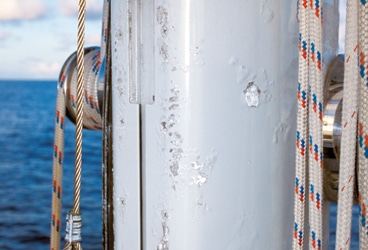
Aluminum Mast Corrosion
If you get the chance, take a close look at the U. S. Coast Guard’s heavy-weather rescue vessel, the venerable 47-foot Motor Life Boat, or any of its other aluminum response craft. Check out the paint job. What you’ll notice, beyond the familiar Coastie stripe and bottom antifoulant, is that these vessels are all unpainted. And it turns out that this saves the Coast Guard untold sums in paint, metal maintenance, and repair while it increases the service life of the alloy hulls.
Hard to believe? Read on.
Once it’s painted, aluminum’s surface becomes essentially starved of oxygen, and as such, it’s incapable of developing and maintaining its corrosion-resistant oxide coating. Provided that the paint coating remains intact, this presents no problem; with no oxygen and no water present, corrosion can’t occur. However, once the coating is breached, it sets the scene for a corrosion cascade.
When water reaches and reacts with the aluminum, it creates aluminum oxide. The reaction initially has access to air via the breach through which the water passes; however, as the aluminum oxide forms, it expands and lifts the paint, allowing the water to travel farther and farther from the initial entry point. Eventually, oxygen can no longer reach the area of interaction, creating an environment ripe for poultice corrosion.
The result is the formation of an unsightly blister or bulge, beneath which lurks the byproduct of poultice corrosion, aluminum hydroxide. If you’ve never seen it, aluminum hydroxide looks something like freezer-burned vanilla ice cream: It’s often gooey until the blister’s surface breaks, at which point it dries out and reverts more or less to a powdery state.
All too often, professionals and consumers alike conclude that this occurs because the aluminum was improperly or inadequately prepared or primed prior to the application of paint. After all, the failure is one of adhesion; the paint has failed to “stick” to the aluminum, right? Although this scenario does occur, it is, in fact, much less common than anecdotal reports would indicate. In most cases, the cause of the corrosive wound is a result of damage—even minuscule in size—that allows water to reach bare metal. Once the process begins, it’s difficult to stop.
The best defense against such paint failure and the ensuing corrosion? Prevention. When possible, choose anodized rather than painted-aluminum components. Whenever hardware is attached over painted aluminum, the installation is sure to fracture the paint coating, even if only microscopically, but that’s all it takes for water to make its way in. Thus, if aluminum is painted (the only reason to paint aluminum is for cosmetic appearance or for anti-fouling purposes), make sure all hardware is thoroughly bedded using a polyurethane compound. The simple isolation of the components with non-metallic “gaskets” is advantageous, but bedding is still required.
The next defense is rapid repair. If a painted-aluminum fixture is scratched or nicked or if poultice blisters form, attack them quickly by removing loose paint, cleaning the area, and coating with a primer suitable for aluminum and any durable paint. Quick is the word of the day when it comes to paint-induced corrosion: The sooner the problem is addressed the better.
Steve D’Antonio offers services for boat owners and buyers through Steve D’Antonio Marine Consulting








